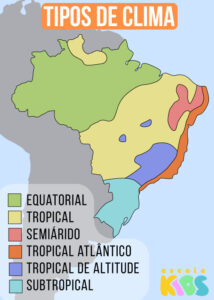Blog
Climate in Brazil: Facts, Temperatures & Precipitation
- Wednesday April 26th, 2023
- Posted by: Amanda Ennes
- Category: Brazil

Brazil is a vast country located in South America, known for its tropical climate, diverse ecosystems, and biodiversity. However, several factors affect the climate in Brazil, including the size of the country, its position in the globe, and the influence of ocean currents and winds. In this text, we will explore the climate in Brazil, its characteristics, and the challenges posed by climate change.
Brazil’s climate can be classified into five main categories: equatorial, tropical, semi-arid, highland tropical, and subtropical. Let’s check them.
Table of Contents
ToggleEquatorial Climate in Brazil
With temperatures generally above 25°C, the equatorial climate has high temperatures and abundant rainfall throughout the year. This climate is found in the northern part of the country. Moreover, it supports a wide range of ecosystems, including the Amazon rainforest. The high humidity and rainfall provide ideal conditions for plant growth, resulting in a lush and diverse forest ecosystem. However, deforestation and climate change pose significant threats to this ecosystem. There is an increased risk of droughts, wildfires, and loss of biodiversity.
Tropical Climate in Brazil
The tropical climate in Brazil is the most common in the country. It presents high temperatures and a distinct wet and dry season. Prevalent in most of Brazil, it is strongly influenced by the Amazon rainforest. During the wet season, which lasts from December to May, there is abundant rainfall and high humidity, supporting the growth of lush vegetation. In contrast, the dry season, which lasts from June to November, exhibits reduced rainfall and an escalated risk of wildfires.
Semi-arid Climate in Brazil

Featuring high temperatures and low rainfall, the semi-arid climate is prevalent in the northeastern region of Brazil. This climate connects with the Caatinga biome, a unique and fragile ecosystem. This biome is home to a diverse range of wildlife that have adapted to survive in the harsh conditions of the region. The average temperature for the semi-arid zone can vary but usually range from 24 to 28 degrees Celsius. During the summer months, however, temperatures can exceed 40 degrees Celsius. The semi-arid climate in Brazil is also known for its low humidity and high levels of solar radiation.
Highland Tropical Climate in Brazil
The highland tropical climate in Brazil exhibits cooler temperatures and plentiful rainfall throughout the year, with temperatures ranging from 15°C to 25°C. This climate is found in the southeastern and southern regions of Brazil, in the mountainous areas. The high altitude and precipitation provide ideal conditions for the growth of vegetation, which in turn supports a variety of wildlife. This region is home to the Atlantic Forest, a highly biodiverse ecosystem that has been heavily impacted by deforestation and land use change.
Subtropical Climate in Brazil
Lastly, the subtropical climate features mild temperatures and well-distributed rainfall throughout the year, with temperatures generally between 10°C and 20°C. This climate is found in the southernmost region of Brazil. The subtropical region supports a range of ecosystems, including forests, grasslands, wetlands, and coastal ecosystems. Moreover, temperatures in this region can be lower than in other regions, and there is a clear difference between the four seasons.
Factors affecting the climate in Brazil
Brazil’s position near the equator and the influence of ocean currents play a crucial role in the country’s climate. The South Equatorial Current brings warm and humid air from the Atlantic Ocean to the coastal areas of Brazil. It contributes to the high temperatures and abundant rainfall. The cold Falkland Current, on the other hand, is responsible for the low temperatures in the southern part of the country.
Brazil’s climate is also affected by the Amazon rainforest. The Amazon is responsible for regulating the temperature and rainfall patterns in Brazil and the surrounding regions, acting as a natural air conditioner. However, deforestation and climate change are posing a threat to the Amazon. This may result in severe consequences for Brazil’s climate and the world’s temperatures.
Caminhos Language Centre is the largest and most exciting Portuguese school in Rio de Janeiro, Brazil. We have an excellent infrastructure, over 15 experienced Brazilian teachers, and a friendly multilingual support staff. We are the only school in Brazil able to offer Portuguese group courses throughout the year on 10 different levels. Moreover, our school also offers more than just Portuguese lessons for foreigners, we offer you the complete Rio de Janeiro experience. Every day we organize 100% free and fun activities for you to socialize and practice your Portuguese. We can also help you with a student visa for Brazil and accommodation in Rio de Janeiro. Follow us on Instagram for some Portuguese tips and news.


 Deutsch
Deutsch Français
Français Português
Português Español
Español


